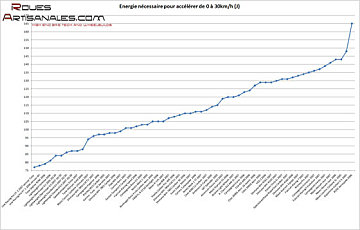Inertia tests
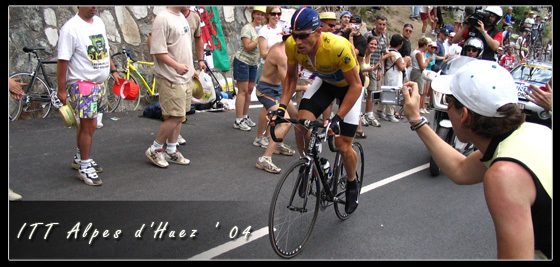 Photo credit : www.photos-dauphine.com
Photo credit : www.photos-dauphine.com
Our second installment focuses on inertia – another very important characteristic. Inertia has a signficicant impact on performance, although it has to be viewed in the context
of the total weight of bike and rider.
When switching from cheap heavy wheelset to a high-end light one, both the rotational and translational energy required are reduced, meaning easier and better handling and acceleration. We will see below how far we can expect a performance rise.
The protocol
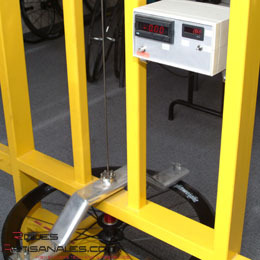 The wheel is fixed horizontally, by its axle, on the bench. A rod, with a known second moment of inertia, is fixed to the bench and the wheel’s rim. It acts as a torsional spring once the wheel is released and allows the wheel to move with a pendulum motion. Its period « T » is recorded.
The wheel is fixed horizontally, by its axle, on the bench. A rod, with a known second moment of inertia, is fixed to the bench and the wheel’s rim. It acts as a torsional spring once the wheel is released and allows the wheel to move with a pendulum motion. Its period « T » is recorded.

We can calculate the inertia of the wheel, in g/m² using this value.
To provide a consistent measure in Joules, we calculate the energy required to accelerate from 0 to 30km/h for each wheelset tested:

With v², the translational wheel speed in m/s. At 30km/h, it is 8,33m/s.
With m, the mass of the corresponding elements, in kg.
With I, the inertia momentum corresponding, in kg/m²
Basically, of the work required to accelerate a wheel from 0 to 30km/h, 40% is rotational and 60% is translational. However, tire choice has a significant impact. Indeed, spinning the
tyre accounts for more than half of the rotational energy because it is far from the rotating axle: the inertia momentum of a component changes with the square of the distance from the rotational axle (m x r²).
Some clinchers also require rim tape which adds 10-20g near to the perimeter of the wheel. It’s obviously possible to create lighter rims for tubulars than clinchers for structural reasons, but the weight of the rubber is also an important factor. In short, if inertia is an important consideration in a given event, your choice of tyres, tubes or tubulars can be just as important as your choice of wheel.
A 235g tire system (tubular or clincher + inner tube + rim tape) was used in the test.
The results / Interpretations
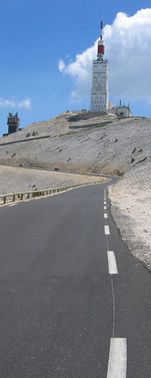
www.lemontventoux.net
The wheels are ranked by energy required on the graph below.
Obviously, the latest super light wheel tests such as Lew Racing, Lightweight, Tune KOM or Olympic Gold and Speedcomposites Sinus have the lowest inertia and require less energy to accelerate. From 77J to 88J, far best in this comparison and even create a gap with the next best wheelsets: for example the Mavic CCU, leading the second group.
Their very light rims, sometimes even deep, will provide easier accelerations and better handling compared to heavier and more conventional wheels.
However, beware crosswinds: light and deep rims tend to act as a sail… Lew have created on a lip generator at the spoke to rim insertion to prevent airflow from stalling,
which should in theory reduce the sail phenomenon.With a Lightweight Ventoux, a Reynolds KOM rim or the Speedcomposites, the shallower rim (sub 30mm) substantially reduces side forces and steering is less adversely
affected in crosswinds. On the other hand, in purely aerodynamic terms, they will be slower… but hey, a perfect wheelset for all conditions will never exist!
About the more traditional, less exclusive wheels, we have a few observations. Taking the first group from 95J to 115J, most have carbon rims: Mavic CCU, Shimano carbon, Campagnolo carbon, Ritchey, Fulcrum, Easton, Corima, Zipp, Sonic, Vuelta, Citec Carbon, Ambrosio. There’s only one alloy wheeset in this group: the Mavic R-SYS. Mavic’s hollow carbon spokes at lower tension – what they call TraComp – allow less material in the rim resulting in lower inertia. In this group, the wheels are high performers, light and relatively high-end in most cases.
The bunch above 115J is mostly composed of alloy rimmed wheels, despite a few recalcitrant carbon wheels (the heavier very deep or higher density rims). The wheels in this group are fairly basic and designed for training or fun rides, although the price of some of them might lead you to believe they are top racing wheels… The Mavic Ksyrium, the Specialized Roval aren’t that different from the American Classic 420 or the Shimano sold at less than 300 euros, and often even less than 200 euros! OK we are only speaking about inertia here but we would expect better from what the respective manufacturers call « high end wheelsets ». Beside this, the very cheap wheels we mentioned are fairly stiff and relatively aero…
The last wheels, over 130J where a plateau is visible, are all quite heavy and designed for cheap bikes. They are mostly reliable and solid: Campagnolo Scirocco, Fulcrum Racing 5, etc.
A performance rise?
If we refer to Newton’s formula at the top of this page, we can calculate the power saved by a low inertia wheelset, compared to a heavy set. Viewed in the context of the bike plus rider weight, the translational energy is very high and far more important than the rotational energy.
For example, a 70kg rider who has a 5kg bike, equips it with a set of Lew Racing Pro VT-1 Tune version 2007 and 235g tubes. Total rider and bike weigh 75kg.
If he swaps to Mavic Aksium Race, total rider and bike weight is 76.74kg.
Ignoring resistance of the air, bearings, tire on the road and chain, the rider will have to provide 2649 Joules in the first case to accelerate from 0 to 30km/h. Meaning approximately 265 Watts to get to 30km/h in 10 seconds.
If the rider chooses the « heavy » wheels, he will have to provide 2720 Joules, and thus 272 Watts.
Hence in this scenario, the Lews have a 7W advantage for 10s, for a low speed acceleration.
We’ve chosen extreme examples to illustrate the point. Obviously, the difference will be lower if we swap a Campagnolo Hyperon for a Eurus (about 3W).
You can see results for the 78 wheelsets we tested in the table below:
| Model | Energy (J) *1 | Weight (g) | Extra power (W) *2 |
| Lew Racing Pro VT-1 2008 Tune version | 74 | 820 | 0,00 |
| Lew Racing Pro VT-1 2007 Tune version | 77 | 899 | 0,30 |
| Lew Racing Pro VT-1 2006 WI version | 78 | 924 | 0,40 |
| Tune Skyline KOM 2006 | 79 | 885 | 0,50 |
| Lightweight Ventoux Obermayer 2006 | 81 | 933 | 0,70 |
| Lightweight Obermayer G1 2005 20/20 | 84 | 1065 | 1,00 |
| Lightweight Obermayer G3 2008 16/20 | 84 | 990 | 1,00 |
| Reynolds KOM 2008 | 85 | 1037 | 1,10 |
| Lightweight Standard G3 2008 16/20 | 86 | 1090 | 1,20 |
| Roval Alpiniste SL Carbon 2008 | 86 | 1039 | 1,20 |
| Lightweight Ventoux DT 2008 | 86 | 1039 | 1,20 |
| Lightweight Standard G3 2008 20/20 | 87 | 1103 | 1,30 |
| Speedcomposites Sinus 2007 24/28 | 87 | 1073 | 1,30 |
| Tune Olympic Gold 2005 | 88 | 1075 | 1,40 |
| Zipp 202 2008 | 89 | 1075 | 1,50 |
| Reynolds DV UL 46 2008 | 93 | 1164 | 1,90 |
| Topolino VX 4.0 2008 | 93 | 1169 | 1,90 |
| Mavic Cosmic Carbone Ultimate 2007 | 94 | 1205 | 2,00 |
| Shimano WH-7850 C24 TU 2008 | 96 | 1245 | 2,20 |
| Campagnolo Hyperon 2006/2008 | 97 | 1255 | 2,30 |
| Ritchey WCS Carbon 2005 | 97 | 1295 | 2,30 |
| Corima – Tune – Aerolite 2007 | 98 | 1245 | 2,40 |
| Shimano WH-7801 Carbon 2006 | 98 | 1305 | 2,40 |
| Easton EC90 SLX 2008 | 98 | 1256 | 2,40 |
| Zipp 404 2008 | 99 | 1274 | 2,50 |
| Sat Lite 5.8 2008 | 100 | 1328 | 2,60 |
| Bontrager Race XXX Lite 2008 | 100 | 1296 | 2,60 |
| Corima Aero 2007 | 101 | 1455 | 2,70 |
| Easton Tempest II Carbon 2005/EC90 Aero 2008 | 101 | 1380 | 2,70 |
| Fulcrum Racing Speed 2006/2008 | 102 | 1350 | 2,80 |
| FSA K-Force RD480 2008 | 102 | 1354 | 2,80 |
| Campagnolo Bora G3 2005/2008 | 103 | 1400 | 2,90 |
| Xentis Mark 1 2005 | 103 | 1455 | 2,90 |
| Bontrager Race X Lite Carbon Aero 2005 | 105 | 1420 | 3,10 |
| FRM FL-R 23 SD Aerolight 2006 | 105 | 1335 | 3,10 |
| Mavic R-SYS 2007 | 105 | 1374 | 3,10 |
| Zipp 808 2007 | 107 | 1455 | 3,30 |
| Fulcrum Racing Light 2008 | 107 | 1401 | 3,30 |
| Vuelta Carbon Pro WR 2006 | 108 | 1510 | 3,40 |
| Shimano WH-7850 C50 TU 2008 | 109 | 1489 | 3,50 |
| Shimano WH-7801 Carbon 50 2006 | 110 | 1540 | 3,60 |
| Sonic Hyper 50mm 2008 | 110 | 1436 | 3,60 |
| Corima Turbospoke 2006 | 111 | 1645 | 3,70 |
| Xentis Mark 1 TT 2007 | 111 | 1594 | 3,70 |
| Citec 6000 Cx Carbon 2007 | 112 | 1504 | 3,80 |
| Pro RC50 2008 | 112 | 1596 | 3,80 |
| Ambrosio X-Carbo 2005 | 114 | 1655 | 4,00 |
| CKT Splendor 2005 | 115 | 1565 | 4,10 |
| Bontrager Aeolus 5.0 2008 | 118 | 1545 | 4,40 |
| American Classic 420 2007 | 119 | 1553 | 4,50 |
| Mavic Ksyrium ES 2006 | 120 | 1545 | 4,60 |
| Xtreme Light Wheels 2007 | 120 | 1609 | 4,60 |
| A-Class ALX 440 SL 2007 | 121 | 1616 | 4,70 |
| Campagnolo Eurus 2006 | 123 | 1590 | 4,90 |
| FSA RD-600 2006 | 124 | 1650 | 5,00 |
| Spinergy Stealth Full Carbon C 2008 | 125 | 1698 | 5,10 |
| Citec 3000S Aero 16 rayons 2006 | 127 | 1625 | 5,30 |
| Citec 3000S Aero 2005 | 129 | 1695 | 5,50 |
| HED 3 2006 | 129 | 1940 | 5,50 |
| Shimano WH-R561 2007 | 129 | 1804 | 5,50 |
| Shimano WH-R550 2007 | 130 | 1824 | 5,60 |
| Easton Vista SL 2007 | 131 | 1775 | 5,70 |
| Specialized Roval Rapid Star Carbon 2007 | 131 | 1847 | 5,70 |
| Shimano WH-R560 2006 | 132 | 1840 | 5,80 |
| Mavic Cosmic Carbone SL Premium 2008 | 132 | 1849 | 5,80 |
| Mavic Ksyrium Equipe 2007 | 133 | 1856 | 5,90 |
| Fulcrum Racing 7 2007 | 134 | 1873 | 6,00 |
| Ritchey Pro 2007 | 135 | 1876 | 6,10 |
| Campagnolo Scirocco 2007 | 136 | 1869 | 6,20 |
| Fulcrum Racing 5 Evolution 2007 | 137 | 1888 | 6,30 |
| Campagnolo Vento 2007 | 139 | 1883 | 6,50 |
| Mavic Aksium race 2007 | 141 | 1973 | 6,70 |
| Mavic Aksium race 2006 | 143 | 1965 | 6,90 |
| Mavic Cosmic Carbone SL 2005 | 143 | 1985 | 6,90 |
| Ambrosio XXL 2008 | 145 | 2108 | 7,10 |
| Gipiemme Carbon 5-5 2005 | 148 | 2040 | 7,40 |
| Rose Aerospoke 2006 | 165 | 2450 | 9,10 |
*1Energy required to accelerate from 0 to 30km/h (J). It includes both the rotationnal and translational energy.
*2Extra power (W) required to accelerate from 0 to 30km/h in 10s from the best wheels. It includes the 70kg rider weight and its 4,1kg bike (without wheels and so 5kg bike with
the lightest wheels).
NB: with a 210g tire system instead of a 235g, you can save about 4J, meaning a nice 0,4W save per each 0 to 30km/h acceleration.
Conclusion
We can draw a few important conclusions from this comparison. Essentially the best solution is to have two wheelsets optimised for different conditions:
– The first set is alloy and lower cost. Keep in mind that most of the the big manufacturers high end alloy wheels are not that expensive. Indeed, the differences they offer compared to the lowest budget alloy wheels are often minimal in term of aero and inertia. To be clear, the difference in term of inertia between a Campagnolo Eurus or a Mavic Ksyrium ES (both about 900 euros) and a Shimano WH-R561 (less than 300 euros!) is close to zero. In terms of aerodynamics, we demonstrated in our previous installment that these high cost alloy wheels are slower than the low budget wheels previously mentioned…!
– The second set spins with a carbon rim. We lavish funds saved with the cheap alloy wheels here where the performance benefits are more significant. You get a very light wheelset that will help you save power thanks to the deep rim (aerodynamic) and low inertia.
Pick it from the lead group (from 95 to 115J), or in the first breakaway (sub 95J) if you have the cash. The custom handbuilt wheels are obviously among the best performance/price solutions.
Last but not least, don’t forget the tyre! It has a big impact on overall performance: its inertia is about half a complete light wheel and its rolling resistance will be as important as
your (our?!) superfluous pounds!
Vocabulary
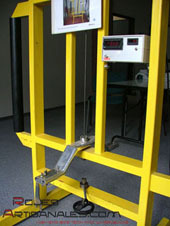
Kinetic energy : In Joules, is the energy required to change the speed of an object from A to B. Kinetic energy increases with the square of the speed.
Inertia : Inertia represents the resistance of an object to remain at rest or keep its momentum. The inertia is a bit like kinetic energy at a given speed.
Inertia momentum : Identical to the simple inertia but for a spinning motion.
Second moment of inertia: It is a property of a shape which is used to predict its resistance to bending and deflection (such as a spoke).
Part 0 – Introduction
Part 1 – Aerodynamics
Part 3 – Lateral stiffness
Part 4 – Bearing resistance
Part 5 – Conclusion

